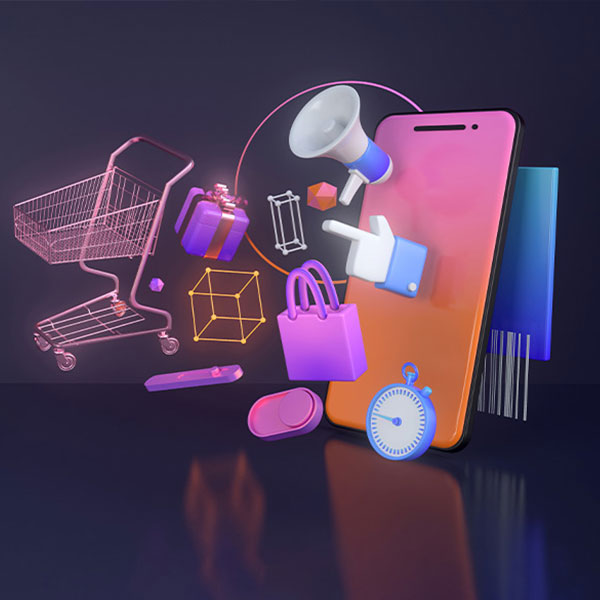A brief overview of the challenges and trends prevailing in the retail industry in 2022, alongside a look at existing technologies that can be used to reverse the damage of the Covid-19 pandemic.
Last year saw the lowest global retail sales in nearly 25 years, with many experts predicting that 2022 will likely be only marginally better. Arguably, the biggest and most visible economic impact of the Covid-19 pandemic has been on retail stores and businesses that relied on customer footfalls.
Facing an existential threat, many retail businesses are fighting hard to adapt quickly by strengthening their virtual retail function. Let us scrutinize the unique retail challenges of the market in 2022, how businesses can recover, and also look at the available virtual retail solutions that can help.
Snapshot
-
1
In the face of an uncertain future, retailers need to embrace virtual retail solutions to overcome disruptions and challenges
In the face of an uncertain future, retailers need to embrace virtual retail solutions to overcome disruptions and challenges
-
2
Deploying easy-to-use tech solutions can revive retail businesses and make good of the losses
Deploying easy-to-use tech solutions can revive retail businesses and make good of the losses
What are the challenges of retailers in the present market conditions
-
1
Ensuring the safety of customers and employees
The increased risk of contracting Covid-19 in spaces with closed circulation (namely all retail stores) has meant in-person shopping hasn't picked up even after lockdown restrictions have been lifted. In a recent Deloitte study, only 23% of the respondents expressed trust in the retail industry when it came to health and safety concerns. In addition to implementing and investing in safety upgrades, retail businesses have struggled to keep up with local mandates. These include guidelines like limiting the number of customers or setting up automated sanitation devices.
-
2
Developing omnichannel experiences
To compete with purely digital shopping experiences, retail businesses have been forced to merge the offline shopping experience with the online world. This integrated or omnichannel marketing and engagement framework involves creating a seamless integration between the real and virtual retail world using new and old media. Customers today expect to learn all the information about a product online, even if they purchase it at a physical store later. This means instead of competing with the online shopping experience retail owners must find ways to complement it.
-
3
Supply chain disruptions
For a large part of 2021, vulnerabilities, consolidation, and inefficiencies of the global supply chain impacted all businesses. Right from the auto industry to OEM memory storage manufacturers, every industry struggled to access raw materials. Some of the world's biggest retailers also struggled to meet the rising demand for utilities. Our globalized networks and supply chain exposed the delicate balance of operations. For instance, when restrictions on movement were imposed even in a remote part of the world, its presence was felt on the other side of the globe.
-
4
Talent and labor shortages
Despite being hailed as a front-line heroesâ in many countries, retail workers were in short supply all over the world. The retail industry is infamous for having some of the highest attrition rates, and the situation got even more challenging during the last year. With low wages, limited benefits, and high-pressure jobs in the retail sector, the situation is unlikely to improve in the near future. Furthermore, while it is easy for leading retail chains to hire expert talent to support their digital transition strategy, small and medium businesses have struggled to find the right digital talent or agency.
How can retailers overcome these challenges?
-
1
Re-engage customers to build trust
To expedite the return of shoppers into their stores, retail businesses must re-engage and re-energize their customers with care and support as the foundation. Implementing strict health and safety protocols, following the local mandates related to masks, vaccination, and physical screening, and consulting with experts to minimize health risks for employees and shoppers is essential. In addition, retail stores will have to establish trust with their customers and convey that shopping at their establishment is safe.
-
2
Redesigning the shopping experience
A majority of savvy customers have already shifted their shopping entirely online. Whatâs more, 53% state that they intend to continue the habits over the past year. This indicates a growing need to reimagine the shopping experience from scratch. With customer expectations evolving in short periods, retail businesses will have to give them the novelty of the in-store shopping experience but with the conveniences and benefits of online shopping.
One essential part of this process is to create a unified shopping experience across all channels, be it the website, social media, app, in-store, or third-party locations. This will require optimizing operations across supply chains, smarter inventory management, data-driven marketing, and engagement, and meeting customers where they are.
-
3
Building resilience in the supply chain
While many retailers have resumed normalcy in their supply chain operations, they continue to struggle with backlogs, surging transportation costs, and unpredictable customer demand. Retailers must build resilience in their supply chain management processes to minimize concentration, streamline transportation, and optimize warehouse management. They must invest in order fulfillment and last-mile delivery to fortify each part of the chain while driving all these decisions through the lens of the customer.
-
4
Rebranding the EVP to attract, retain, and motivate employees
Shortages of motivated and skilled workers threatens to derail all, and any, progress made by retailers over the last month. While retail automation has been used to smoothen operational inefficiencies and facilitate customer-facing processes (like self-checkout,) at its core, retail continues to be a human-centric industry. So, it is time for retail businesses to redefine their employer value proposition (EVP) in order to attract, retain, and engage employees. A part of this mix is better wages and benefits, but also caring for employees well-being, offering them development opportunities, and valuing their work.
Existing technology solutions that retailers can leverage to tackle challenges
There are a variety of mature and tested digital tools that can be deployed at retail stores for improving processes and creating better customer experiences:
-
1
Smart fitting rooms and virtual trials
Virtual fitting and try-on tools have become the norm at most leading retail businesses. Powered by advanced augmented reality (AR) and virtual reality (VR) technologies, these tools help customers visualize how certain products look on them without physically trying them on. They usually use the customer images or 3-D models based on measurements to create the rendition. While such technologies were primarily used for virtual shopping, they have been installed across stores and outlets to minimize physical interaction over the past year as well.
-
2
Virtual sales assistants and payment systems
When shopping, 69% of customers want to know about products without touching them, and 76% prefer to pay digitally, a survey by EY shows. This explains why top retailers like H&M, Macyâs, and Walmart have introduced a variety of new digital tools for their in-store customers over the past year. Smart vending machines, virtual sales assistants, menus, and payments facilitated by QR codes, digital price tags, pre-ordering or app-first stores, are just a few examples of contactless display and payment solutions. Others include in-queue and automated checkouts, in-store catalog apps, in-store navigation, and inventory apps.
-
3
Retail digital marketing
A new retail and shopping experience that is digital-first also necessitates the adoption of modern digital marketing tools that drive sales, execute promotional campaigns, and engage customers. Most businesses assume that simply maintaining social media presence is enough to attract and engage customers. However, there are a variety of digital assets and capabilities that must be built to undertake retail digital marketing effectively. These include, but are not limited to, digital stores, mobile apps, online customer support, high-ranking landing pages, location-based NFC marketing, email marketing campaigns, etc.
-
4
Digitizing backend operations
Retailers must also set up sophisticated digital solutions to manage backend operations and internal processes for maximum efficiency and safety. In-store retail analytics, mobile POS and inventory management systems, sales floor assistant tools, virtual retail audit tools, ERP systems, and self-service HRMS platforms can help businesses streamline their processes to operate at maximum capacity. Additionally, special care must be given to defend the systems against malicious actors by securing digital data and assets using appropriate cyber-security technologies.
Retail in 2022 and beyond
Retailers have no choice but to evolve with fast-changing trends and unpredictable customer behavior. This will require them to transform all aspects of the business, including the store premises, supply chain, and the shopping experience for customers. While digital technologies and strategies will be critical to these transformations, retailers will also have to build the right partnerships, cultivate digital expertise, and embrace new ways of reaching their customers.
Retailers today face an unprecedented challenge of surviving in the market as digital alternatives continue to grow. However, technological advancements and data-oriented tools are changing the retail experience as we know it. Download the Retail Whitepaper to understand key challenges in the retail sector and technology-led tools and practices to overcome those challenges.
Read Responses
No Comments
Leave a Reply
Your email address will not be published.


